Buddhist Ganesha: popular Ganapati’s many forms include enlightened Yidam, protector, and “bringer of success”…
Buddhist Ganesha’s appeal is wide-reaching, not just amongst the spiritual. Ganesh tatoos and t-shirts are very popular worldwide. There is, a “life-affirming” quality about his image, even for the non-religious. Ganesha has star power. He even appears in brands, marketing, pop culture and fashion.
And, of course, “Ganesha, also known as Ganapati and Vinayaka, is one of the best-known and most worshipped deities in the Hindu pantheon… Devotion to Ganesha is widely diffused and extends to Jains and Buddhists.”[1]
To many Mahayana Buddhists, Ganesha is an important practice. He can be a Yidam, a friendly “bringer of prosperity,” a Dharma protector deity — and he takes on many other roles. Shakyamuni Buddha suggested his mantras prior to practice. He appears in two Buddhist sutras, and various tantras — in different roles. His mantra may be chanted by all. None of these roles are mutually exclusive.
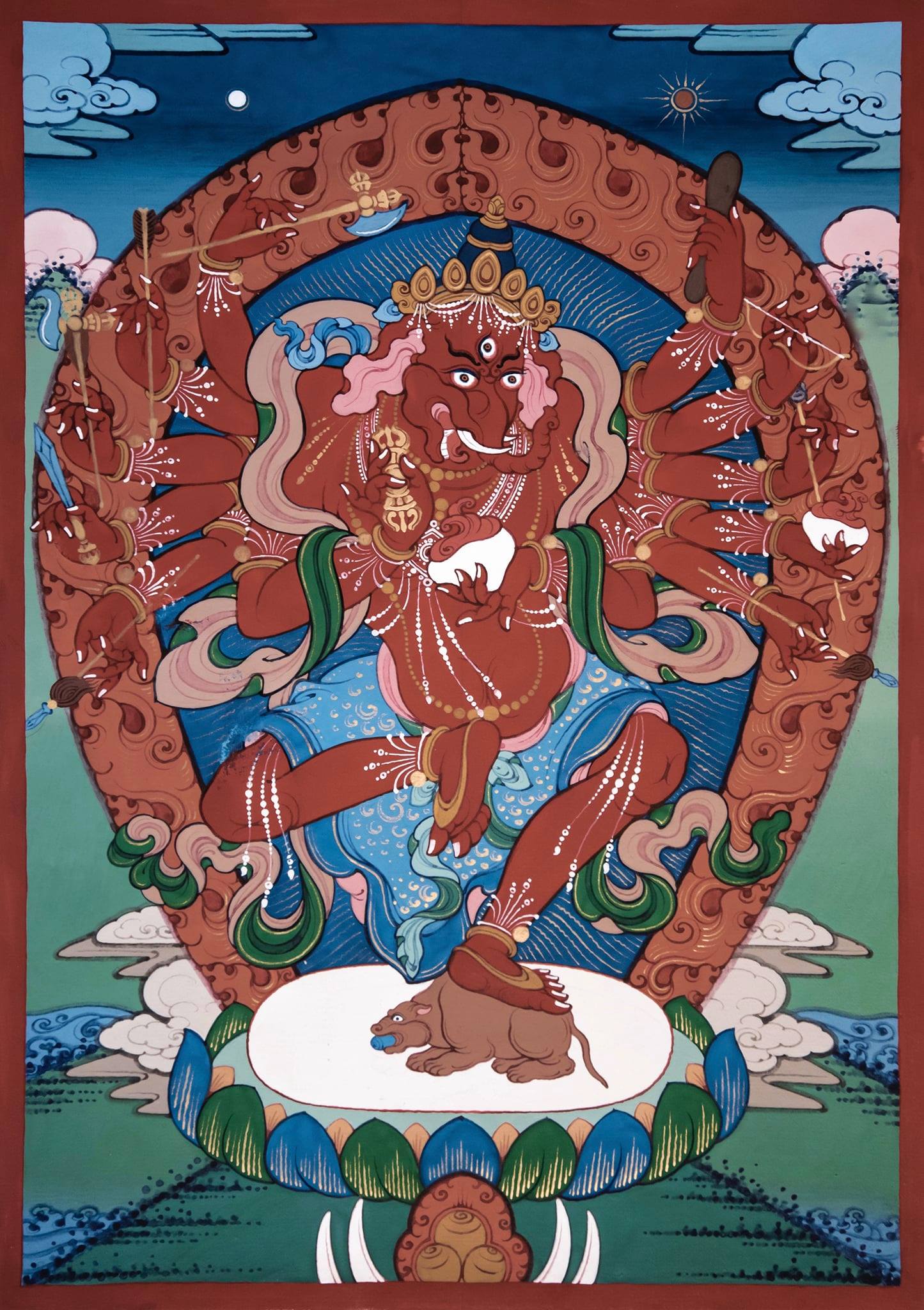
Many Forms of Ganapati
In both Mahayana Buddhism and Tibetan Buddhism, Ganesha (Sanskrit: गणेश, IAST: Gaṇeśa) is the protector of prosperity and the remover of hindrances. In the Sakya and Gelug traditions, Ganesha — together with Vajrayogini and Kurukulla — are the three “red deities” in the Thirteen Golden Dharmas of the Sakyapa tradition. [See the large museum thangka of Hayagriva with Ganesha below.] In other traditions, he is a directional Protector known as Vinayaka. In one of the Tantra stories, Avalokiteshvara convinces Ganesha to become a Dharma Protector. In Hindu tradition, there are at least 32 aspects of Ganesha.
In all of his aspects, he is easily identified by his symbolic “elephant head.”
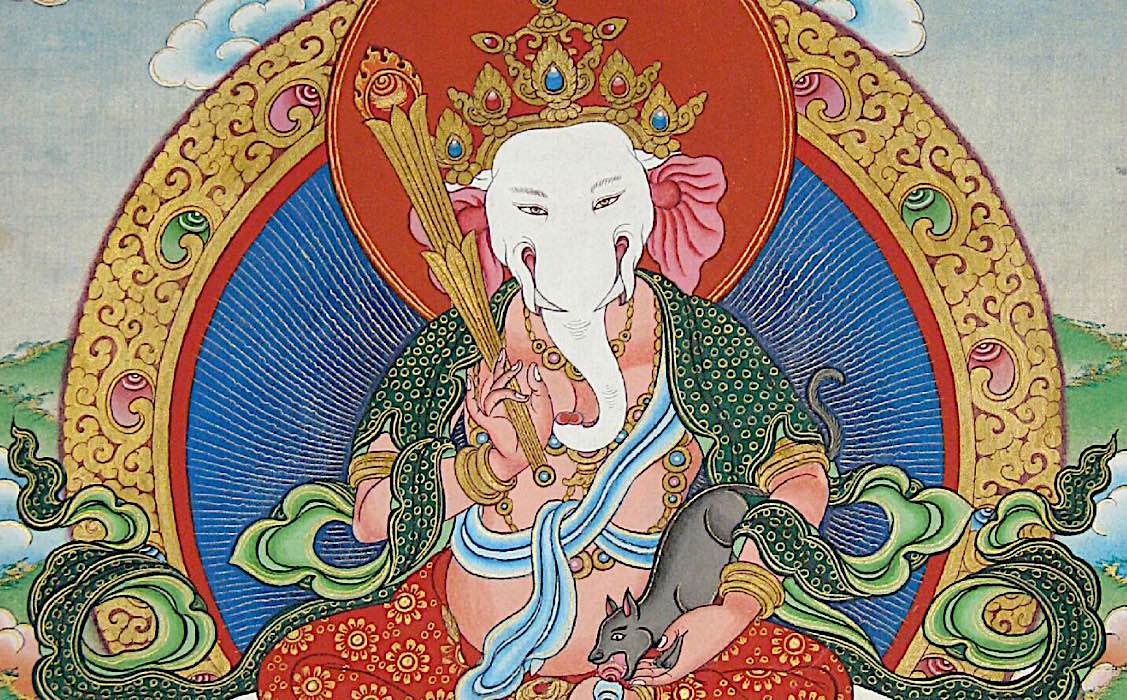
Above: One of Ganesha’s forms in Tibetan Buddhism as a wealth deity associated with Jambhala.
In one sutra Buddha Shakyamuni advises his bikhus to make offerings and recite the essence mantra of Ganesha Ganapati seven times — after first taking refuge in Buddha, Dharma and Sangha. [More on these sutras in the section Origins of Ganesha below.] The reason is to ensure our practice obstacles are removed, so that our meditations result in realizations. The essence mantra of Ganapati is:
Om Ah Ga Hum Svaha
In Tibetan pronunciation: Om Ah Ga Hung Soha.
In one variation on the essence mantra, in the Gelug tradition, accroding to Lama Yeshe Archive, the syllable “PAT” (or “P’hat” or “P’het”; pronounced in Tibetan usually as PEY) [Link to Lama Yeshe archive, FPMT here>>]:
OM AH GA HUM PAT SVAHA
In Tibetan pronunciation:
OM AH GA HUNG PEY SOHA
The seed syllable of Ganesha is GAM. GAM is often worn as a symbol for luck.
In the Hindu tradition, the mantra is slightly different: Oṃ Gaṃ Gaṇapataye Namaḥ.

The popularity of Ganapati is Universal
Why is Ganesha so popular? Is it because he appears so lovable, in appearance friendly, wise, and charming? Is it because his head is symbolically an elephant, one of the most popular of animals? Is it his association with removing obstacles that face us, or his role as the “wealth deity?”
Important: This is a “wiki-like” feature, with Ganesh’s many aspects introduced. However, only you — and your own tradition or teacher or school — should ultimately define how you view Ganesh. It is important to empahasize that Ganesha can appear in different aspects according to the needs of our practice. In other words, there are no right and wrong visualizations.
We collected a variety of references in a Buddhist context. Ganesha appears popularly in various Mahayana and Vajrayana traditions. In some Buddhist traditions Ganesh is worldly — but still and important remover of obstacles. In some Mahayana traditions he is viewed as a god. In others a Enlightened Protector. In yet others, as a Bodhisattva. There is no universality. In one tradition it is Avalokiteshvara who asks Ganesha to be a Dharma Protector. Ganesha later promised again to protect the Dharma before the great Padmasambhava — who composed 108 Sadhanas of Ganesha.
In this feature we’re highlighting all the various aspects. In other words — even where there appear to be contradictions — there is no right, or wrong, in these various views, and ultimately, for practice, one should only be guided by your own tradition and teacher, and your own preferences.
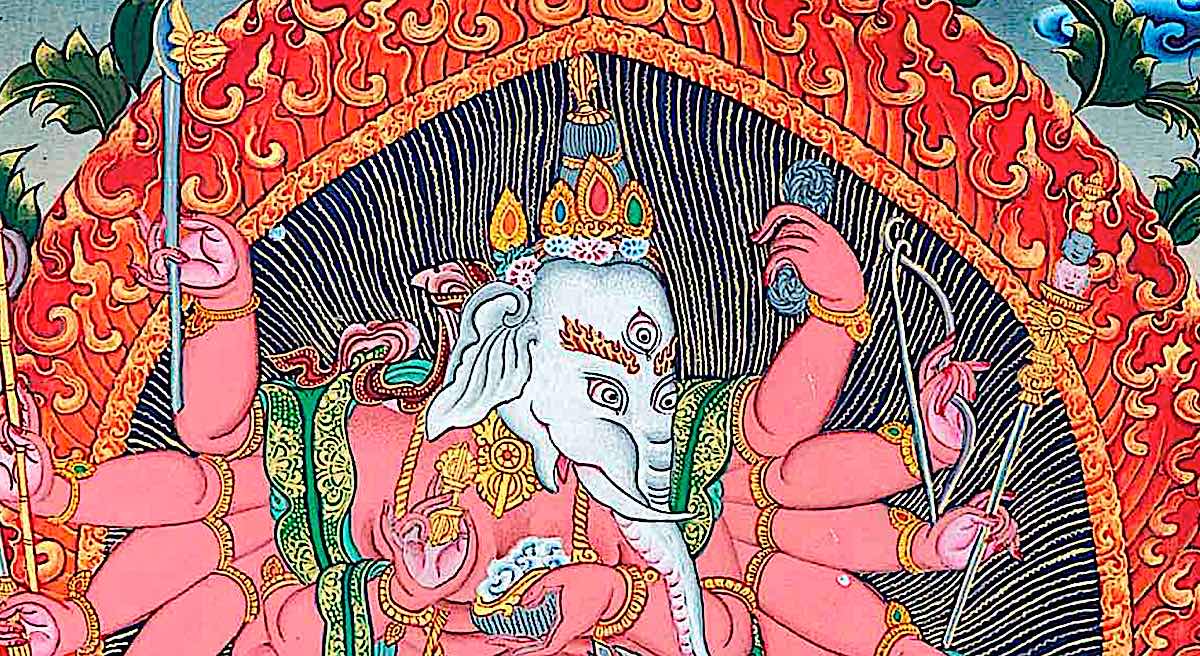
Origins of Ganesha
Of course, Ganesha (Sanskrit: गणेश, IAST: Gaṇeśa) originated with early Brahmanism (Vedism) and is now a vital part of the Hindu faith.
In Buddhism, there are two sutras that mention Ganapati, and one with his “Dharani” (mantra) which can be chanted by anyone. In the sutra, Buddha says:
“Any son or daughter of high birth, whether monk or nun, lay brother or sister who undertakes any matter [such as] accomplishing the [rites to call a sacred being by means of] mantras, worshipping the Three Jewels, travelling to another country, going to the royal court or concealing [from view] should upon worshipping the Blessed Buddha, practice seven times the Arya Ganapati Hrdaya [mantras]: for him all tasks will be accomplished; no doubt about this!
[The full Arya Maha Ganapati Hrdaya Dharani is at the end of this article.]
Two sutras on Ganapati contain the Dharani of Ganapati; one is the Dharani Sutra of the Golden Ganapati, found in the T. XXI 1269, which was delivered by the Buddha to his disciple Shariputra when the Buddha was residing at Shravasti. The Dharani, as presented in this Sutra, is somewhat a variant of the Dharani, in the Ganapati Heart Sutra.
At the end of the Sutra, Ganapati himself appears and assures that he will protect and bestow wishes of those who uphold this Dharani. The other text, the one that is presented here is the “Arya Maha Ganapati Hridaya Dharani” [Heart Dharani of Maha Ganapati] — in full at the bottom of this features.
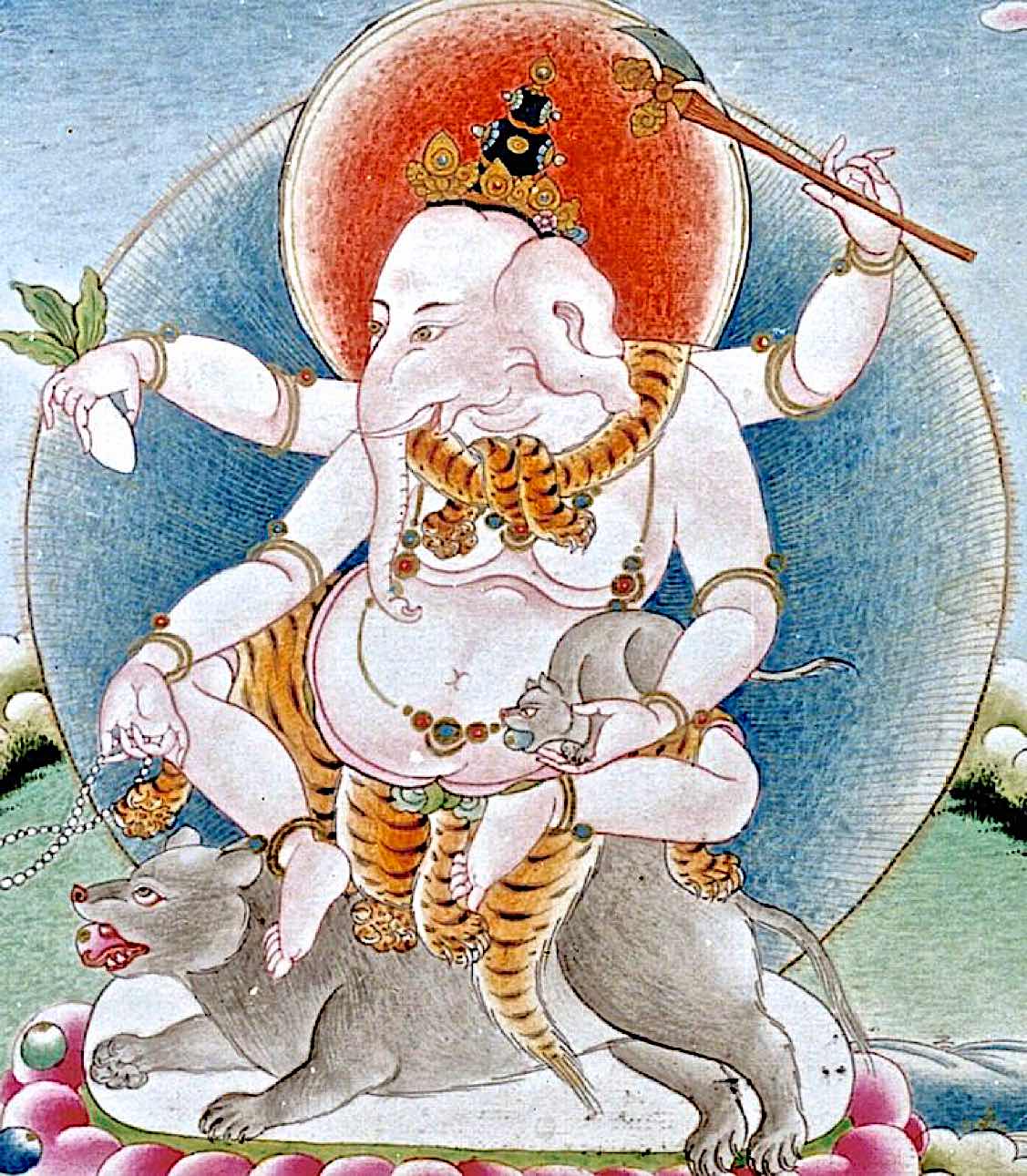
In Buddhism, sometimes Ganesha is seen as a worldly deity dedicated to protecting Buddhism, but in some Mahayana stories he is a Bodhisattva and in origin stories, he is an emanation of Avalokiteshvara (in the Chakrasamvara Cycle of Tantras).
NOTE: Regardless of your views and your traditions — worldly or Enlightened, an emanation or separate, Protector or Yidam — in most cases, he is the remover of obstacles to our practice, a revered deity.
In most Buddhist tantric traditions, Ganesha appears as a protector sworn to protect the Dharma by either Shakyamuni Buddha or Padmasambhava. However, Ganapati, Maha Rakta (Tibetan: ཚོགས་བདག tsog gi dag po, mar chen. English: The Great Red Lord of Hosts or Ganas) is a Tantric Buddhist form of Ganapati (Ganesha) related to the Chakrasamvara Cycle of Tantras. This form of Ganapati is regarded as an emanation of Avalokiteshvara.
“…beside a lapis lazuli rock mountain is a red lotus with eight petals, in the middle a blue rat expelling various jewels, [above] Shri Ganapati with a body red in colour, having an elephant face with sharp white tusks and possessing three eyes, black hair tied in a topknot with a wishing-gem and a red silk ribbon [all] in a bundle on the crown of the head. With twelve hands, the six right hold an axe, arrow, hook, vajra, sword and spear. The six left [hold] a pestle, bow, khatvanga, skullcup filled with blood, skullcup filled with human flesh and a shield together with a spear and banner. The peaceful right and left hands are signified by the vajra and skullcup filled with blood held to the heart. The remaining hands are displayed in a threatening manner. Wearing various silks as a lower garment and adorned with a variety of jewel ornaments, the left foot is extended in a dancing manner, standing in the middle of the bright rays of red flickering light.” (Ngorchen Konchog Lhundrup, 1497–1557).
This form of Ganapati belongs to a set of three powerful deities known as the ‘mar chen kor sum’ or the Three Great Red Deities included in a larger set called ‘The Thirteen Golden Dharmas’ of Sakya. The other two deities are Kurukulle and Takkiraja. (See 18th century Thangka of Hayagriva Sangrup below with Ganapati and Kurukulle both featured below.)
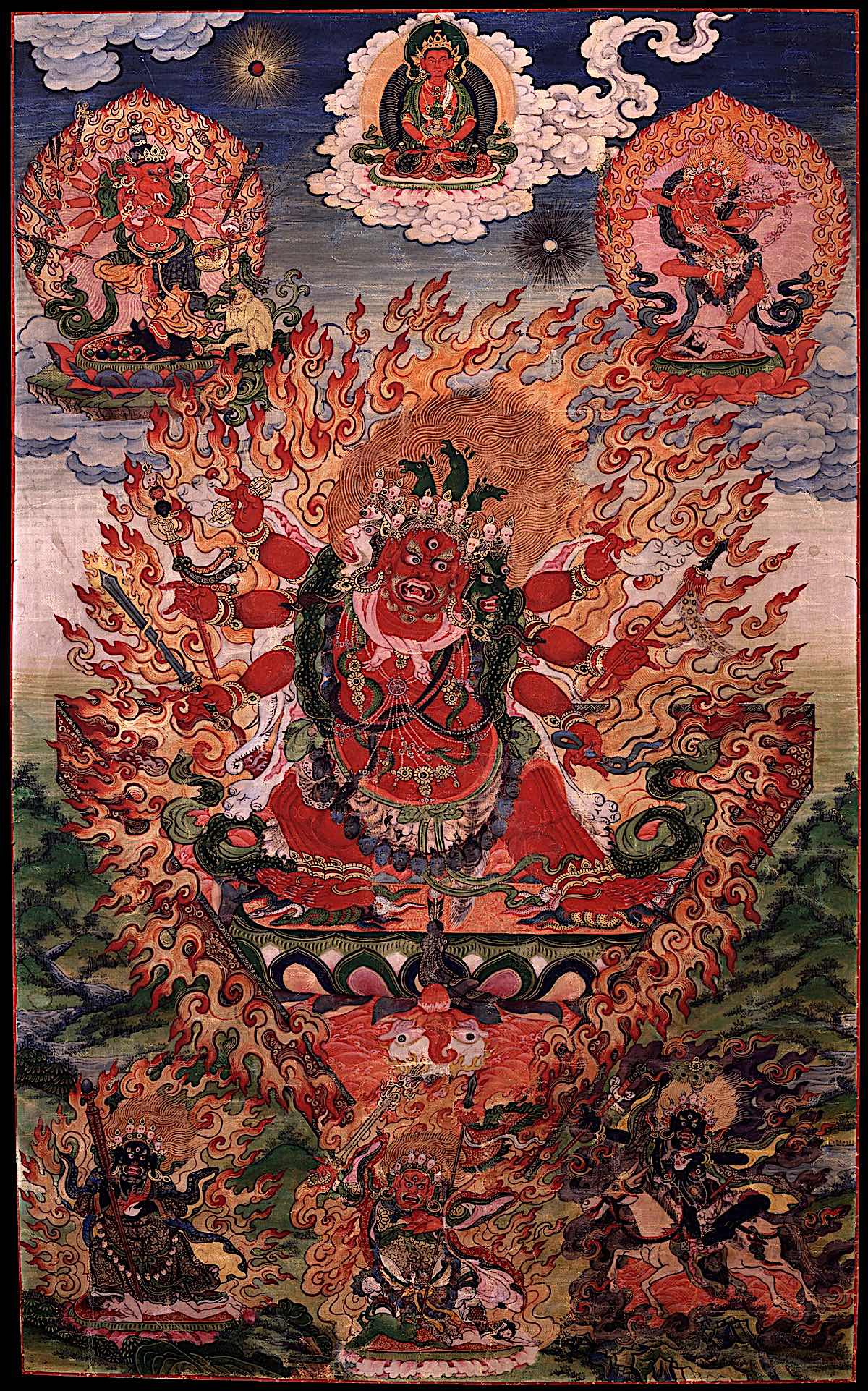
Vinayaka Ganesha
In one tantric description of Ganesha’s Divine Lila (Lila means “dramatic play”,) Avalokiteshvara, determined to convince Ganesha to be a Dharma protector, transforms his appearance to an image of Ganesha and enters his palace, sitting on his throne. The entire palace, including Ganesha’s consort, are convinced this is the real Ganesha. When Ganesha returns, he is astonished by Avalokiteshvara’s majesty and becomes an Protector of the Dharma.

It depends on the tradition and teacher. In yet another tradition, Mahanirvana Tantra, he was converted by the protector Mahakala — Mahakala being a fierce form of Avalokiteshvara — and symbolically appears under his feet, representing the King of Protectors
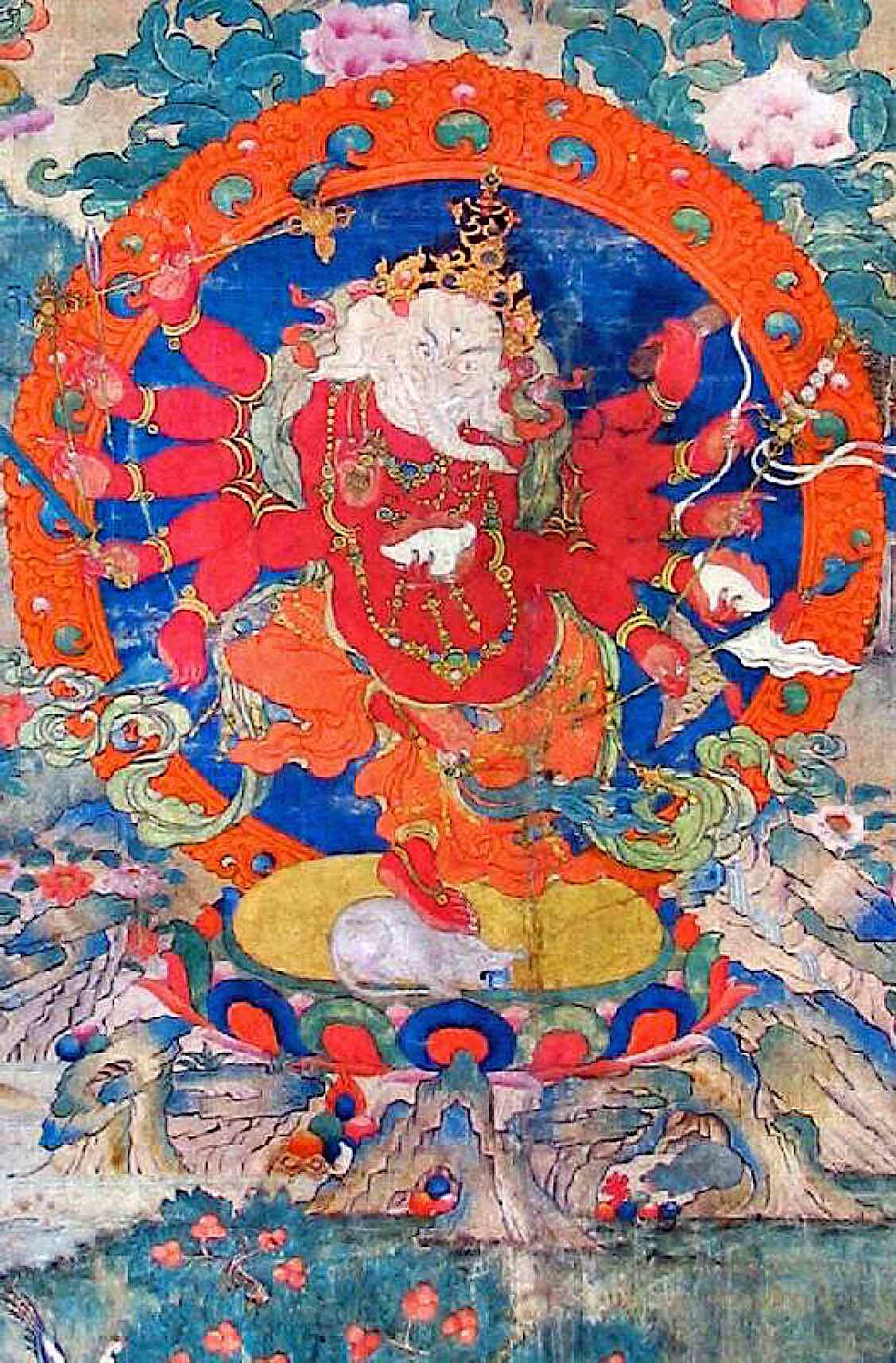
Less worship, more practice
From the Buddhist perspective on deities, there is less “worship” of deities and more “practice” of deities as a path. In Tantric Buddhism, for example, we visualize ourselves as the perfect forms of Enlightenment — as the deities — this, as practice for our mindstreams.
That doesn’t mean we don’t make offerings or honor deities. Offerings and prostrations help us develop positive karmic imprints — merits, as they are often called.
Most Ganesha practices — the ones not requiring extensive initiations or permissions — are conducted to “ask for the removal of obstacles to our practice.” Normally, in tantric practice, we would visualize ourselves as our own Yidam — not as Ganesha — then make offerings to Ganesha (in whatever form is taught to us.)
Wonderful voice of Tibetan Buddhist nun Ani Choying Drolma, chanting Ganesha mantra:
His long Dharani, according to the Blessed Shakyamuni Buddha, will “obtain and propagate … the accomplishments of his [Ganesha’s] tasks.” The sutra-based Dharani, requiring no permission (see the full Sutra at end of this feature) is:
oṃ namo ‘stu te mahāgaṇapataye svāhā |
oṃ gaḥ gaḥ gaḥ gaḥ gaḥ gaḥ gaḥ gaḥ |
oṃ namo gaṇapataye svāhā |
oṃ gaṇādhipataye svāhā |
oṃ gaṇeśvarāya svāhā |
oṃ gaṇapatipūjitāya svāhā |
oṃ kaṭa kaṭa maṭa maṭa dara dara vidara vidara hana hana gṛhṇa gṛhṇa dhāva dhāva bhañja bhañja jambha jambha tambha tambha stambha stambha moha moha deha deha dadāpaya dadāpaya dhanasiddhi me prayaccha |oṃ rudrāvatārāya svāhā |
oṃ adbhutavindukṣubhitacittamahāhāsam āgacchati |
mahābhayamahābalaparākramāya mahāhastidakṣiṇāya dadāpaya svāhā |
oṃ namo ‘stu te mahāgaṇapataye svāhā |
oṃ gaḥ gaḥ gaḥ gaḥ gaḥ gaḥ gaḥ gaḥ |
oṃ namo gaṇapataye svāhā |
oṃ gaṇeśvarāya svāhā |
oṃ gaṇādhipataye svāhā |
oṃ gaṇapatipūjitāya svāhā |
oṃ suru suru svāhā | oṃ turu turu svāhā | oṃ muru muru svāhā |
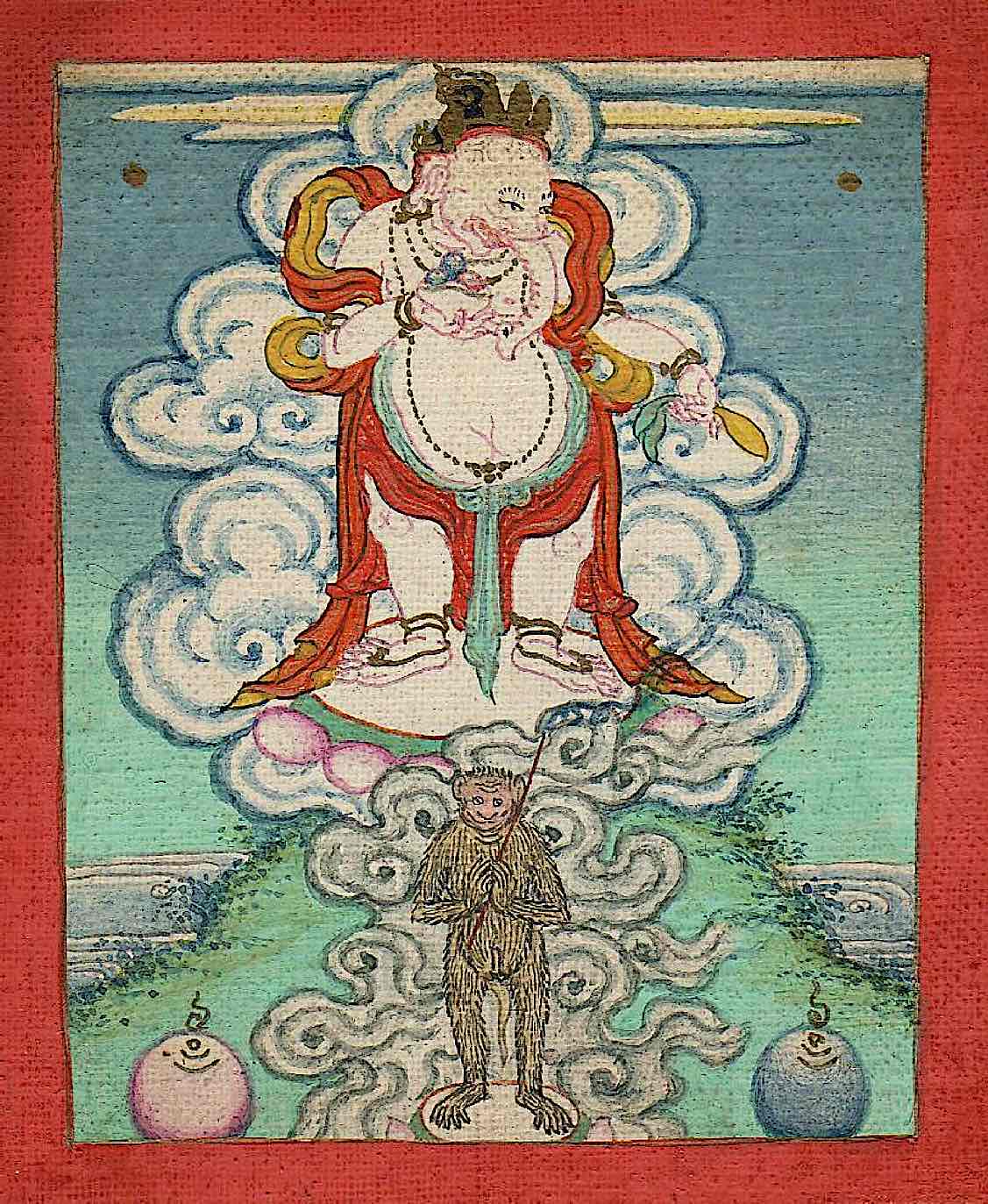
Ganesha comes first
Ganesha is normally the first deity practiced or honored in some Buddhist (and Hindu) traditions. Why? Because he is known as the “remover of obstacles.” It is symbolically important to remove obstacles before, for example, moving on to your main practices.
Many deities are known as “obstacle removers” in Tantric Buddhism, and often these are practiced first in daily sadhanas — although it varies by tradition. It is for this reason, too, that Ganesha is often at the door of temples, or homes. He removes obstacles and is, by this definition, a guardian.
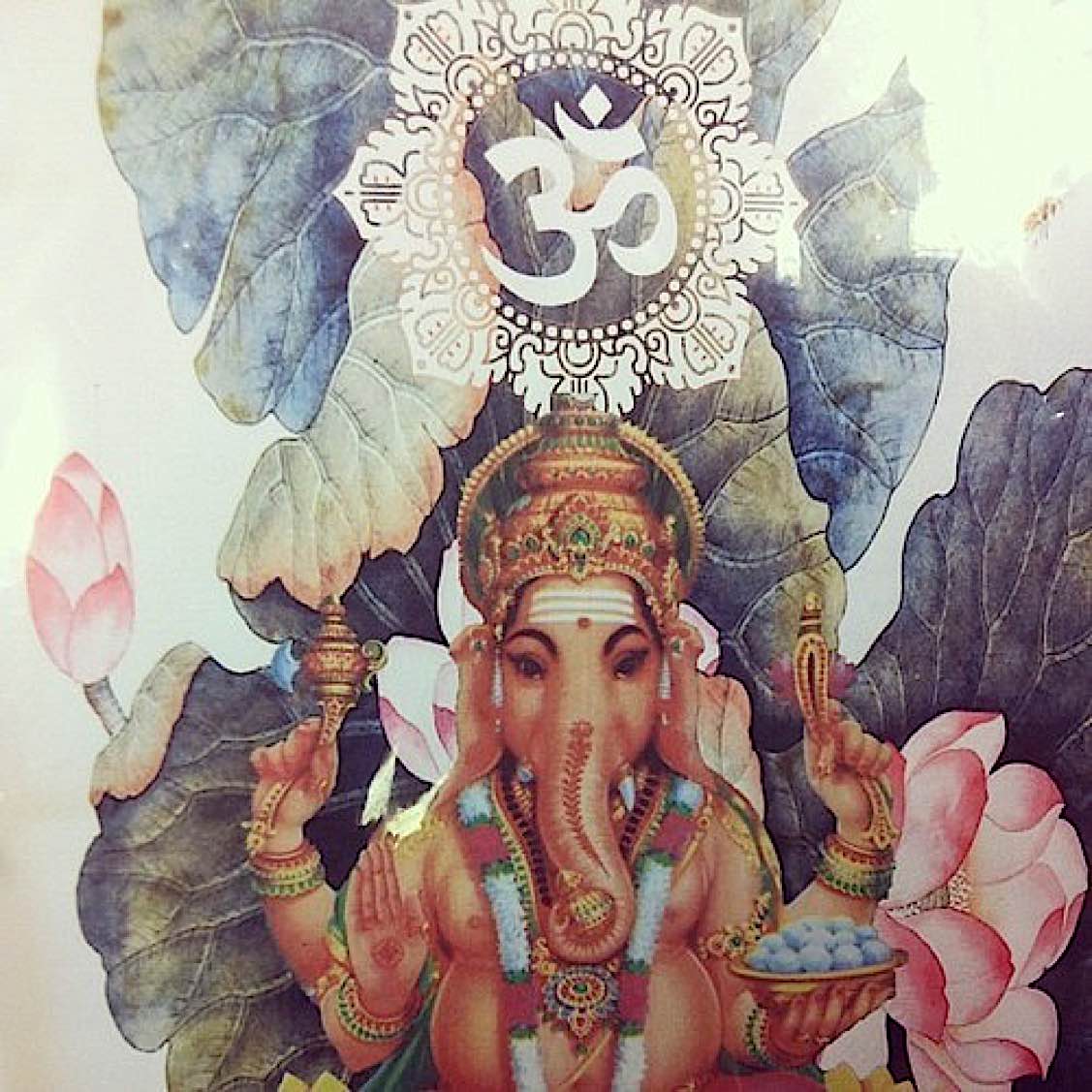
Obstruction-remover
Importantly, in Buddhism, Ganapati (Ganesha) is a “remover of obstacles.” Many Buddhist deities are, removers or obstacles, but Ganesha is particularly venerated for this role.
Since poverty is a major obstacle — if we are fighting to survive, we have no time to practice Dharma — Ganesha also takes on a “wealth deity” role.
Some of his depictions overlap with Jambhala (another wealth deity, and also another Hindu deity), complete with depictions of gold and jewels falling from the mouth of his rat. (In the case of Jambhala the animal is a mongoose). Red Jambala, especially, is usually thought of as none other than Ganesha, Red Ganapati, with the head of an elephant (see thangka below.)

Many forms of Ganesha
Importantly, Red Ganapati in common with many “red” deities belongs to the Padma family in Tibetan Buddhism — the family of Avalokiteshvara, Hayagriva, and Amitabha. In one traditional lineage of Chinese Buddhism, where Guanyin (Kuan Yin, Avalokiteshvara) is female, Ganesh is her consort.
Ganesha’s Buddhist enlightened forms are many: overcoming obstacles and bringing success (similar to Hinduism); fierce protector at the gate of many mandala palaces; high-form tantric deity; and, even, in Chinese Buddhism, a legendary consort to Guan Yin.
In Shingon, he is popular as Kankiten. In Japan there are 250 stand-alone Ganesh temples, where he is the god of prosperity and happiness. As Nrtta Ganapti, the dancing Ganesha, he is the destroyer of obstacles in Tibet and Nepal. In Thailand he is called Phra Phikanet, a deity of fortune and success. In Indonesia he is associated with wisdom. He is also the Buddhist deity Vinayaka, popular in Tibet.

He is worshiped widely in India (by both Buddhists and Hindus) and by Buddhists in China, Thailand — where Ganesh amulets are very popular — Tibet, Mongolia, Nepal (basically all of Japan, China, Central Asia, and southeast Asia) — and around the world. In India, he is in every temple, regardless of the main deity, and he is in nearly every home. In Chinese Buddhism, he is extremely popular. He is even a “fix” for homes with bad “feng shui.”
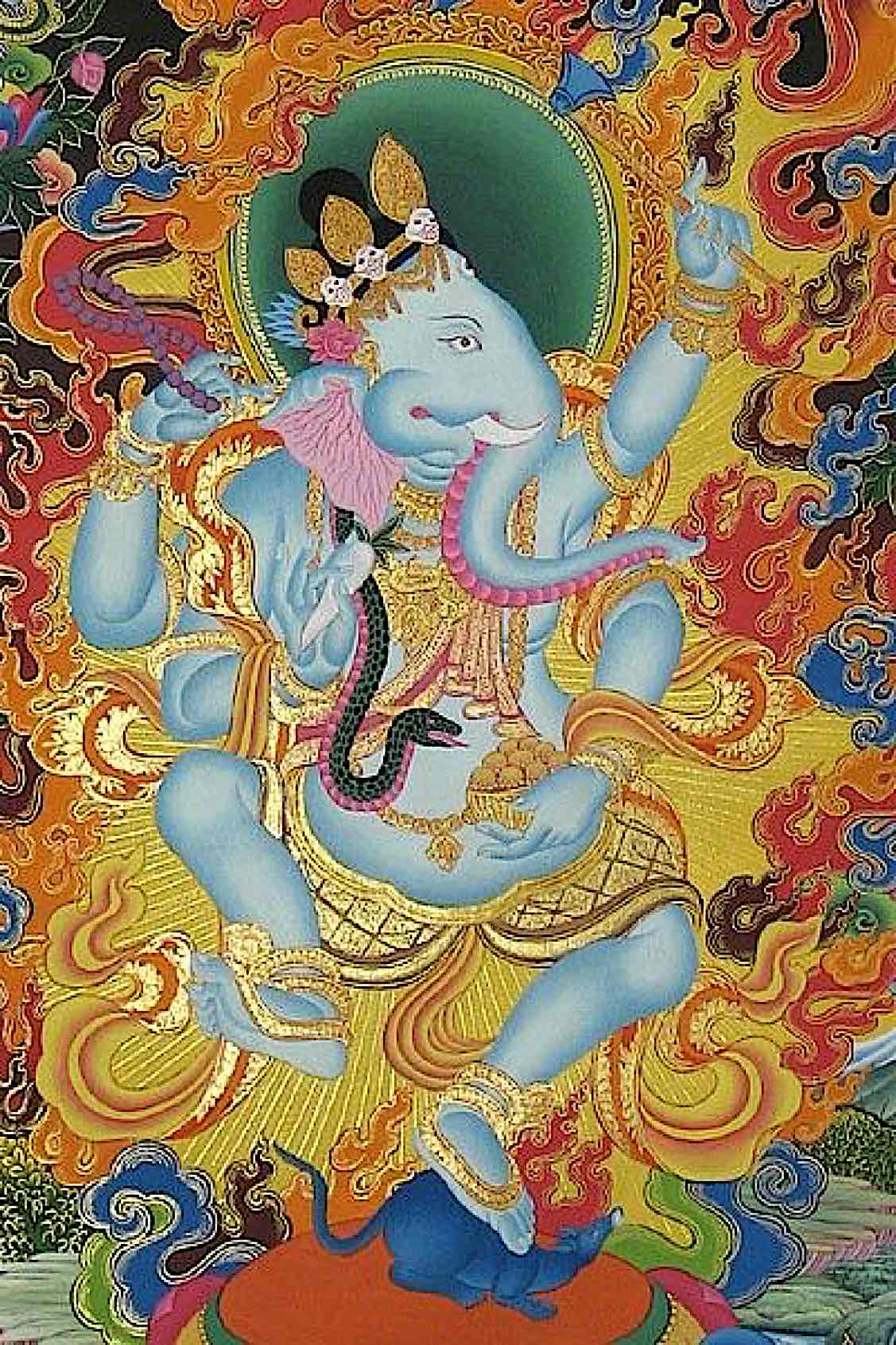
Aspects of Buddhist Ganesha
There are, as with all deities in Buddhism, many symbolic forms in Tantric practices. Each pose, arm, implement, and gesture triggers recognition as archetypes by our minds.
Ganesha, in Buddhism, can be elephant-faced, dancing, with matted locks of hair and many arms and implements. He can be red and fierce, as with Maha Rakta Ganapati (Great Red Lord of the Ganas). He can look very nearly like Hindu Ganesha. He can have three eyes — symbolic of wisdom and Enlightenment. He can carry a kapala filled with blood, symbolic of bliss and emptiness. In most forms, the “mouse” mount is carried over from Hinduism symbolism.
Some of his forms:
- Lord Ganesh, pale of complexion with a mouse mount (similar to Hindu form).
- Maha Rakta Ganapati: red and fierce tantric form with many arms, an emanation of Avalokiteshvara (related to the Chakrasamvara tantras)
- Nrtta Ganapati, the dancing god.
- He is one of the Three Great Red Deities (Mar Chen Kor Sum), which is part of the Thirteen Golden Dharmas of the Sakyas.
- He can be Vinayaka (which is both the name of an enlightened deity and a demon) — and in this form he is sometimes seen being stepped on by Mahakala.
- Kangiten in Japan, a wealth and success god.
- Ragavajra: Three-faced, six hands (Atisha tradition)
- One-face- four hands (white, red or blue)
- Maharakta Red, one-face-twelve hands
- One face, two hands (white)
- Nyingma forms of Ganapati, such as Maha Ganesha or Vajra Ganesha
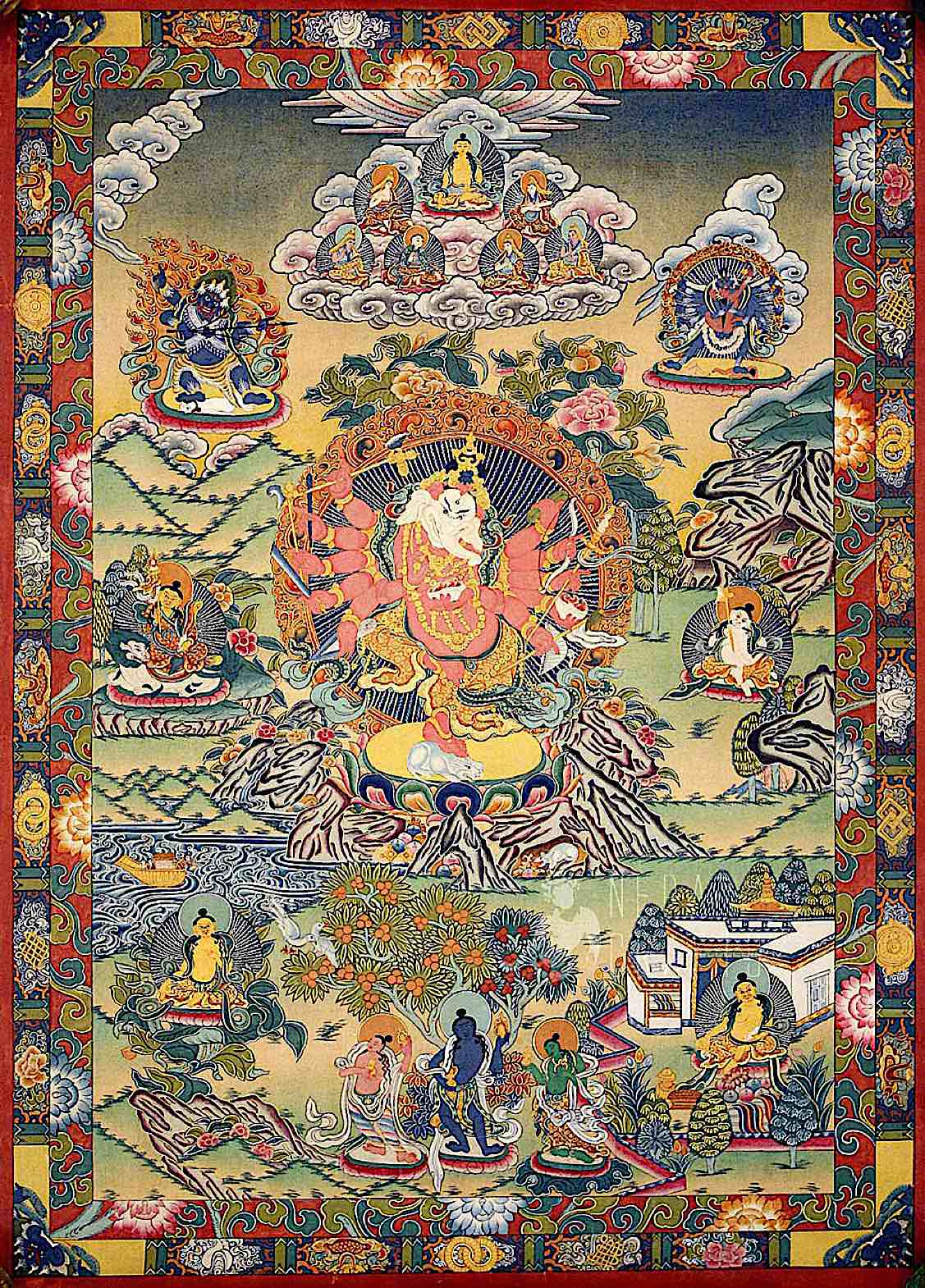
Maharakta Ganapati — emanation of Avalokiteshvara
Perhaps the most exotic of the Ganapati forms is Maharakta, instantly recognizable by his red form, surrounded by red tantric flames on a red lotus. This form is related to the Chakrasamvara tantras. The description from Ngorchen Konchog Lhundrub (1497-1557):
“…beside a lapis lazuli rock mountain is a red lotus with eight petals, in the middle a blue rat expelling various jewels, [above] Shri Ganapati with a body red in colour, having an elephant face with sharp white tusks and possessing three eyes, black hair tied in a topknot with a wishing-gem and a red silk ribbon [all] in a bundle on the crown of the head. With twelve hands, the six right hold an axe, arrow, hook, vajra, sword and spear. The six left [hold] a pestle, bow, katvanga, skullcup filled with blood, skullcup filled with human flesh and a shield together with a spear and banner. The peaceful right and left hands are signified by the vajra and skullcup filled with blood held to the heart. The remaining hands are displayed in a threatening manner. Wearing various silks as a lower garment and adorned with a variety of jewel ornaments, the left foot is extended in a dancing manner, standing in the middle of the bright rays of red flickering light.”
Maharakta blongs to the “Three Great Red Deities” (mar chen kor sum), along with red Kurukulla and Takkiraja.

Offerings to Ganesha
There isn’t much difference between offering recommendations for Buddhist Ganesh or Hindu Ganesh. Relatively, they may seem like distinct deities, but at the ultimately level they are One. Typically, in Buddhism, water bowls are always a perfect offering for any deity.
But, symbolically, Ganesh prefers “sweet treats” and “sweet smells” and “sweet flowers.” Why? Because Ganesh is just plain “sweet.” In formal retreat or practice, usually the “three white” offerings are made: yogurt, rock sugar, milk.
Ganesh loves flower garlands. (Because he’s sweet!). The best offering of all is his mantras. (Depending on the form you are honoring, the mantra may vary.)
Normally, the offerings are placed before a picture or statue of Ganesh, but in Tantric Buddhism, this can be just projected mentally through visualization (as always, with Tantric Buddhist deities.)
Pujas or sadhanas of Ganesh will differ in a significant ways between Buddhist and Hindu. The key to any Buddhist sadhana or ritual is:
-
Taking refuge in Buddha, Dharma and Sangha, the Three Jewels
-
Making the Bodhisattva vow (with each practice)
-
Dedicating the merit of the practice to the cause for Enlightenment for the benefit of all beings.
Ārya Mahā Gaṇapati Hṛdaya
namo bhagavate āryamahāgaṇapatihṛdayāya |
namo ratnatrayāya ||
 Thus I have heard. Upon a time, the Blessed One was staying at Rajagriha, on the Vulture Peak, together with a great assembly of monks: forty-five hundreds of monks and numerous great Bodhisattvas. On that occasion the Blessed One told the Venerable Ananda:
Thus I have heard. Upon a time, the Blessed One was staying at Rajagriha, on the Vulture Peak, together with a great assembly of monks: forty-five hundreds of monks and numerous great Bodhisattvas. On that occasion the Blessed One told the Venerable Ananda:
“Ananda, whoever, son or daughter of high birth, would keep [in mind], recite, obtain and propagate these “heart” [mantras] of Ganapati, his will be the accomplishments of all his tasks”
oṃ namo ‘stu te mahāgaṇapataye svāhā |
oṃ gaḥ gaḥ gaḥ gaḥ gaḥ gaḥ gaḥ gaḥ |
oṃ namo gaṇapataye svāhā |
oṃ gaṇādhipataye svāhā |
oṃ gaṇeśvarāya svāhā |
oṃ gaṇapatipūjitāya svāhā |
oṃ kaṭa kaṭa maṭa maṭa dara dara vidara vidara hana hana gṛhṇa gṛhṇa dhāva dhāva bhañja bhañja jambha jambha tambha tambha stambha stambha moha moha deha deha dadāpaya dadāpaya dhanasiddhi me prayaccha |
oṃ rudrāvatārāya svāhā |
oṃ adbhutavindukṣubhitacittamahāhāsam āgacchati |
mahābhayamahābalaparākramāya mahāhastidakṣiṇāya dadāpaya svāhā |
oṃ namo ‘stu te mahāgaṇapataye svāhā |
oṃ gaḥ gaḥ gaḥ gaḥ gaḥ gaḥ gaḥ gaḥ |
oṃ namo gaṇapataye svāhā |
oṃ gaṇeśvarāya svāhā |
oṃ gaṇādhipataye svāhā |
oṃ gaṇapatipūjitāya svāhā |
oṃ suru suru svāhā | oṃ turu turu svāhā | oṃ muru muru svāhā |
“These Ananda, are the “hearts” of Ganapati”
“Any son or daughter of high birth, whether monk or nun, lay brother or sister who undertakes any matter [such as] accomplishing the [rites to call a sacred being by means of] mantra, worshipping the Three Jewels, travelling to another country, going to the royal court or concealing [from view] should upon worshipping the Blessed Buddha, practice seven times the Arya Ganapati Hrdaya [spells]: for him all tasks will be accomplished; no doubt about this!. He should forever put an end to all strifes and quarrels , violence and envy, and become entirely calm. Day upon day abiding the rules and practicing a full seven times: it will come out into the fortune of this great one! Upon his coming to the royal court there will be great kindness (prasada). He will become “Keeper of hearing [1]” (Shruti-Dhara). There wil be no major illness to his body. Never will he assume the descent as a tara-praksina or the descent as a humble bee: nothing ellse will occur to him that the Mind of Awakening. In every birth he will be remembering [his previous] births.”
Thus spoke the Blessed One, and upon receiving [his teaching] these monks, these great Bodhisattvas and whole attendance, the world with the gods, the humans, the asuras, the garudas and the gandarvas rejoiced at the words of the Blessed One.
NOTE:
[1] From Ganesha article on Wikipedia.
7 thoughts on “Buddhist Ganesha: popular Ganapati’s many forms include enlightened Yidam, protector, and “bringer of success”…”
Leave a Comment
More articles by this author
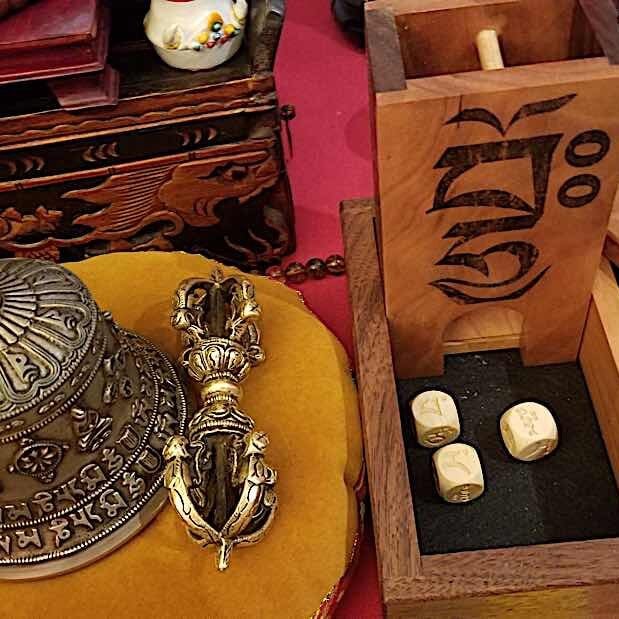
Mo Dice and Mo Mala, Bamboo Sticks, and other “divinations” — “Mo could prove beneficial…” HH Sakya Trizin
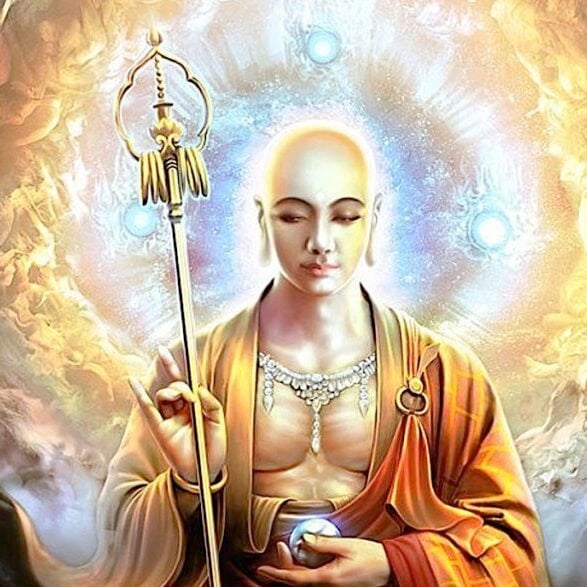
Lama Zopa Rinpoche and other teachers recommend Kṣitigarbha mantra and practice for times of disaster, especially hurricane and earthquake, because of the great Bodhisattva’s vow

Profound simplicity of “Amituofo”: why Nianfo or Nembutsu is a deep, complete practice with innumerable benefits and cannot be dismissed as faith-based: w. full Amitabha Sutra
Search
Latest Features
Please support the "Spread the Dharma" mission as one of our heroic Dharma Supporting Members, or with a one-time donation.
Please Help Support the “Spread the Dharma” Mission!

Be a part of the noble mission as a supporting member or a patron, or a volunteer contributor of content.
The power of Dharma to help sentient beings, in part, lies in ensuring access to Buddha’s precious Dharma — the mission of Buddha Weekly. We can’t do it without you!
A non-profit association since 2007, Buddha Weekly published many feature articles, videos, and, podcasts. Please consider supporting the mission to preserve and “Spread the Dharma." Your support as either a patron or a supporting member helps defray the high costs of producing quality Dharma content. Thank you! Learn more here, or become one of our super karma heroes on Patreon.
Josephine Nolan
Author | Buddha Weekly
Josephine Nolan is an editor and contributing feature writer for several online publications, including EDI Weekly and Buddha Weekly.














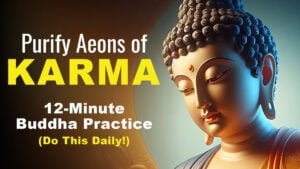

Hi where is this Sutra from? Also the enlightened Ganesh in Chod what text of Chod you are getting this from or what reference (text, teacher anything)? Thank you!
For the Tantric reference: A Gift of Dharma to Kublai Khan By Chogyal Phagpa, Seventh Patriarch of Sakya. Ngorchen Konchog Lhundup, Ngor chos ‘byung, folia 323?328. Translated by Jared Rhoton, 1976). Ganapati, Maha Rakta (Tibetan: ཚོགས་བདག tsog gi dag po, mar chen. English: The Great Red Lord of Hosts or Ganas) is a Tantric Buddhist form of Ganapati (Ganesha) related to the Chakrasamvara Cycle of Tantras. This form of Ganapati is regarded as an emanation of Avalokiteshvara.
“…beside a lapis lazuli rock mountain is a red lotus with eight petals, in the middle a blue rat expelling various jewels, [above] Shri Ganapati with a body red in colour, having an elephant face with sharp white tusks and possessing three eyes, black hair tied in a topknot with a wishing-gem and a red silk ribbon [all] in a bundle on the crown of the head. With twelve hands, the six right hold an axe, arrow, hook, vajra, sword and spear. The six left [hold] a pestle, bow, khatvanga, skullcup filled with blood, skullcup filled with human flesh and a shield together with a spear and banner. The peaceful right and left hands are signified by the vajra and skullcup filled with blood held to the heart. The remaining hands are displayed in a threatening manner. Wearing various silks as a lower garment and adorned with a variety of jewel ornaments, the left foot is extended in a dancing manner, standing in the middle of the bright rays of red flickering light.” (Ngorchen Konchog Lhundrup, 1497–1557).
This form of Ganapati belongs to a set of three powerful deities known as the ‘mar chen kor sum’ or the Three Great Red Deities included in a larger set called ‘The Thirteen Golden Dharmas’ of Sakya. The other two deities are Kurukulle and Takkiraja.
There are two sutras on Ganapati that which contains Dharani of Ganapati. One is the Dharani Sutra of the Golden Ganapati, found in the T. XXI 1269, which was delivered by the Buddha to his disciple Shariputra when the Buddha was residing at Shravasti. The Dharani recorded is very much corrupted. The Dharani, as presented in this Sutra, is somewhat a variant of the Dharani, in the Ganapati Heart Sutra. At the end of the Sutra, Ganapati himself appears and assures that he will protect and bestow wishes of those who uphold this Dharani.
The other text, the one that is presented here is the “Arya Maha Ganapati Hridaya Dharani” [Heart Dharani of Maha Ganapati].
Hi, thank you for the comment. To avoid confusion, we have removed the single-tusked Ganesha images. Thank you again!
Thanks for the article, i have a connection qith Ganesha, this article help to understand Ganesha more
Dear brother,
Namo Buddhaay!
From your comment, it seems you want to oppose Hinduism by saying that Ganesha with one tooth is not real Buddha.
It seems that you chant the name of Buddha but your heart is full of hatred, jealousy and enmity against Hinduism.
These faults are the main obstacles in the path of enlightenment.
Remember Buddha and Ganesha are for all human beings and devas; and not just for one sect or group of practitioners.
Namo Dharmaay!
Hotu sabba mangalam!
Vijay Singh Gautam
Great article, much to talk and discuss. very illuminating for the buddist aspect
I love seeing all of this traditional artwork.